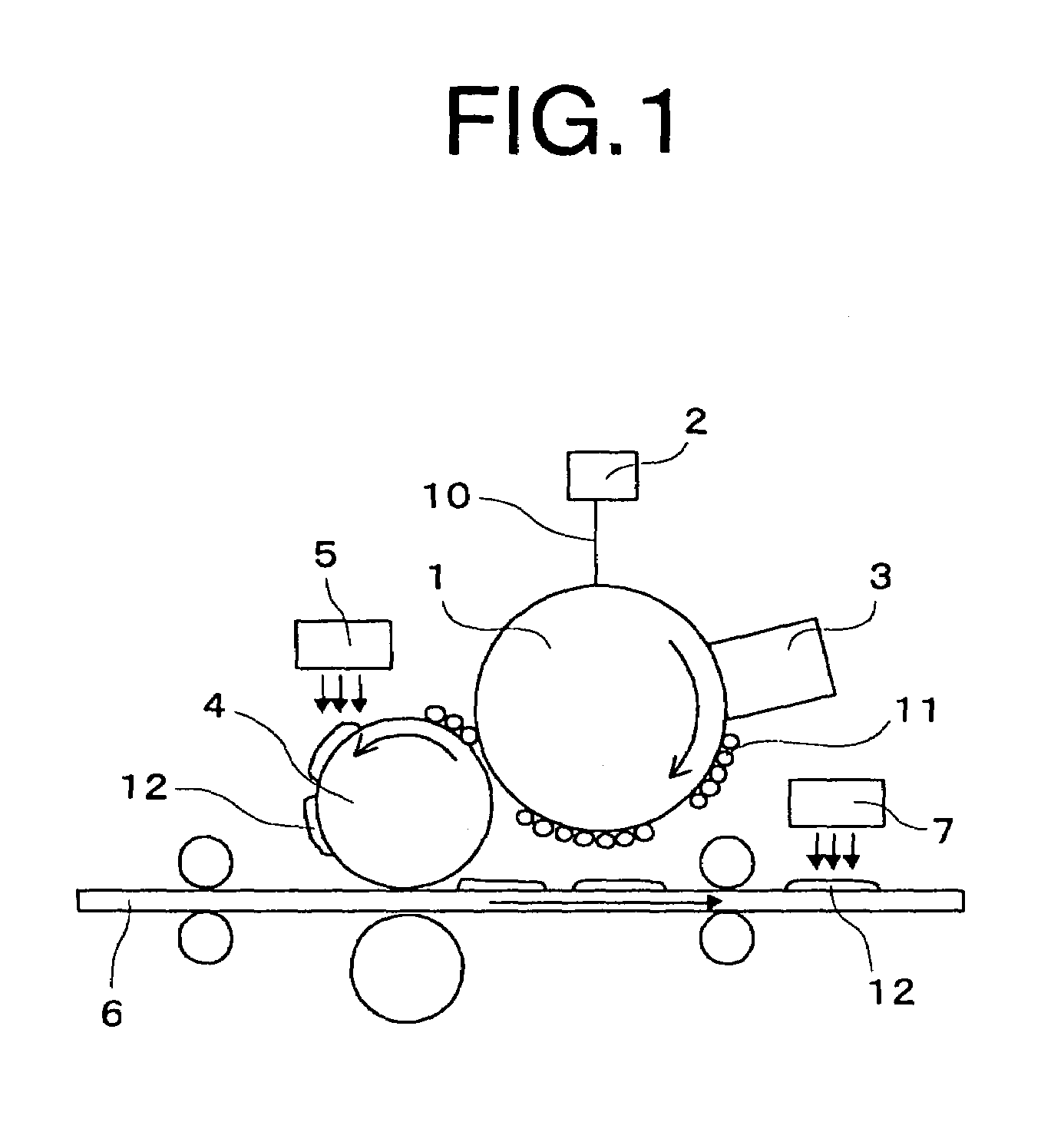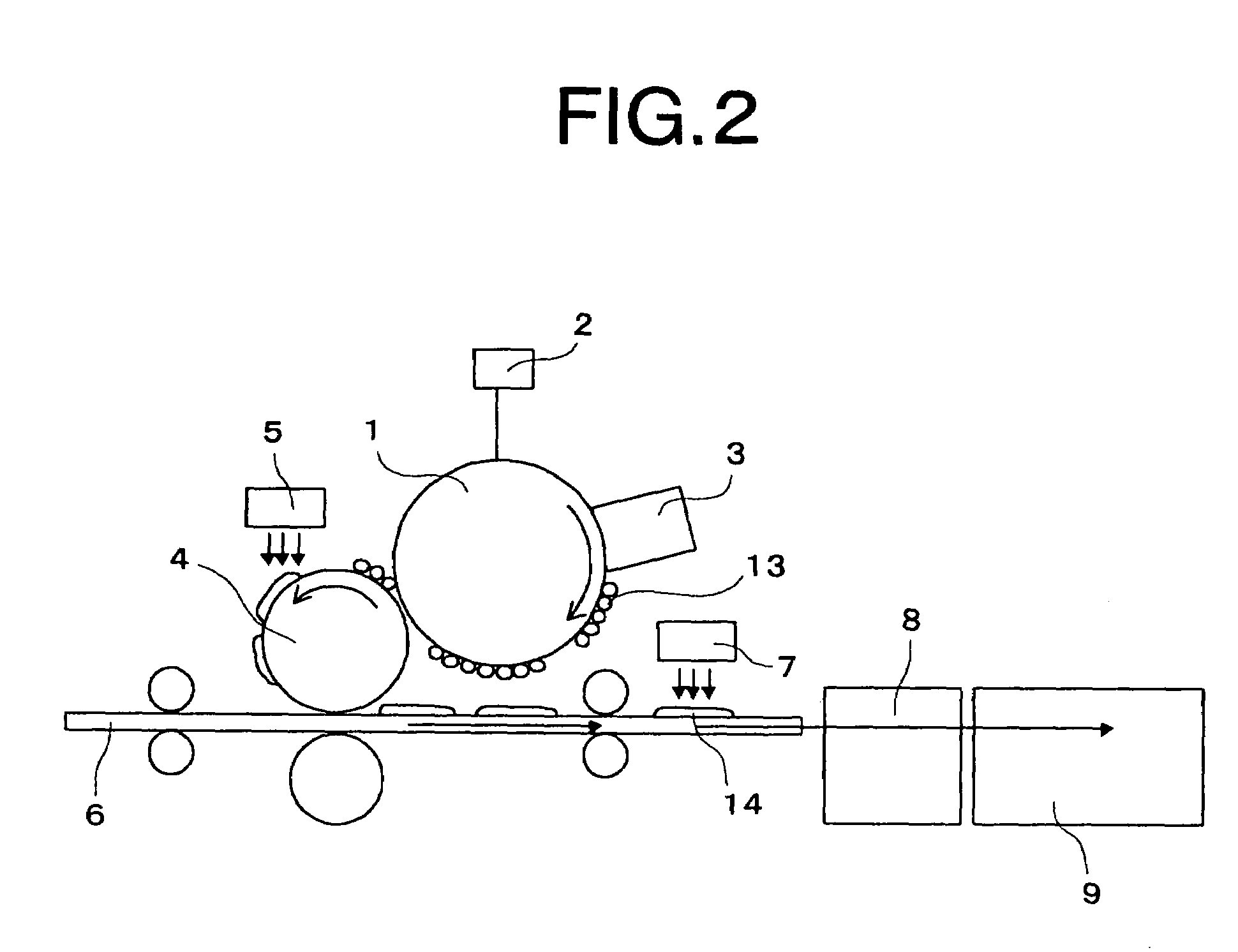Method of manufacturing an electronic circuit and manufacturing apparatus of an electronic circuit
a manufacturing apparatus and electronic circuit technology, applied in the direction of conductive pattern formation, electrographic process, instruments, etc., can solve the problems of inability to impart an electrostatic property to conductive particles in principle, long time for designing and preparing masks, and large influence on the cost and delivery time of circuit boards
- Summary
- Abstract
- Description
- Claims
- Application Information
AI Technical Summary
Problems solved by technology
Method used
Image
Examples
first embodiment
[0038]The first embodiment includes a forming step of an insulating pattern and a forming step of a conductor pattern. The apparatus shown in FIG. 1 is used for forming an insulating pattern. In the forming step of an insulating pattern, the photosensitive drum 1 is first uniformly charged by a not-shown electrifier while being rotated in the arrow direction so that the surface thereof has a certain potential (for example, minus charges). Concrete charging methods includes a scorotron charging method, a roller charging method, a brush charging method, and the like.
[0039]Next, the laser generation / scan unit 2 irradiates the photosensitive drum 1 with a laser beam 10 according to an image signal. Then, the minus charges on a portion irradiated with the laser beam 10 are removed to form an image of charges (electrostatic latent image) in a predetermined pattern on the surface of the photosensitive drum 1.
[0040]The developing unit 3 brings electrified resin particles (charged resin part...
second embodiment
[0055]Next, the present invention will be explained.
[0056]FIG. 4 is a view schematically showing a forming apparatus of an insulating pattern in the second embodiment of the present invention, and FIG. 5 is a view schematically showing a forming apparatus of a conductor pattern used in the second embodiment. In FIG. 4, the same reference numerals are used to designate the same portions as those in FIG. 1 and the explanation thereof will be omitted. In FIG. 5, the same reference numerals are used to designate the same portions as those in FIG. 2 and the explanation thereof will be omitted. In FIG. 4 and FIG. 5, the reference numeral 15 denotes an electric field generating apparatus.
[0057]The second embodiment includes a forming step of an insulating pattern and a forming step of a conductor pattern. The apparatus shown in FIG. 4 is used for forming an insulating pattern. In the forming step of an insulating pattern, a photosensitive drum 1 is charged while being rotated so that the s...
third embodiment
[0076]Incidentally, it is also possible to etch a copper foil of an ordinary copper clad laminate after a resist pattern is formed on the copper foil in the same manner as in the
[0077]In the fourth embodiment, B-staged thermosetting resin (for example, epoxy resin) containing a fluorescent dye is used. As shown in FIG. 7, similarly to the first embodiment, a pattern of a resin layer 12 is formed on a base material 6, and after the thermosetting resin is heated or irradiated with light to be cured by going through a resin curing unit 7, fluorescence from this resin layer 12 is detected for pattern inspection.
[0078]A pattern inspector is composed of an imaging unit 20 such as a camera that detects the fluorescence, an image processing unit 21, a design data storage memory 22, and a comparison operation unit 23a. The pattern of the resin layer 12 (or a conductive metal-containing resin layer) formed on the base material 6 is formed based on digitalized data inputted in advance. When da...
PUM
 Login to View More
Login to View More Abstract
Description
Claims
Application Information
 Login to View More
Login to View More - R&D
- Intellectual Property
- Life Sciences
- Materials
- Tech Scout
- Unparalleled Data Quality
- Higher Quality Content
- 60% Fewer Hallucinations
Browse by: Latest US Patents, China's latest patents, Technical Efficacy Thesaurus, Application Domain, Technology Topic, Popular Technical Reports.
© 2025 PatSnap. All rights reserved.Legal|Privacy policy|Modern Slavery Act Transparency Statement|Sitemap|About US| Contact US: help@patsnap.com



